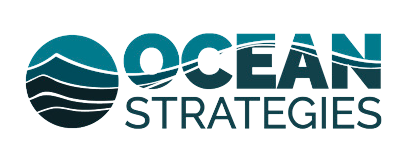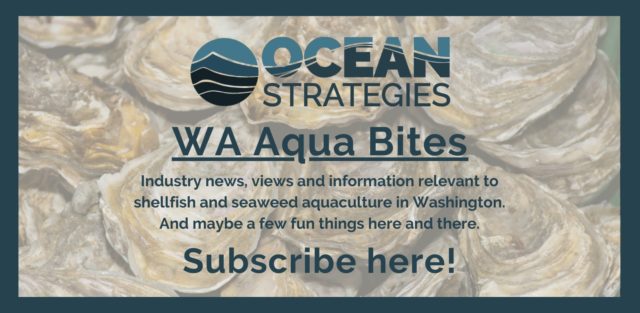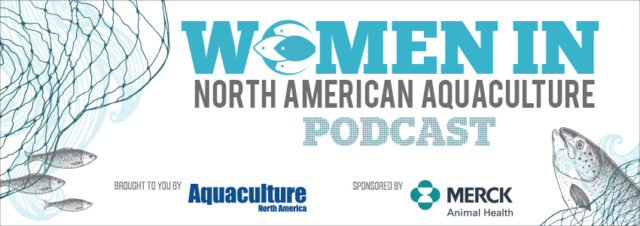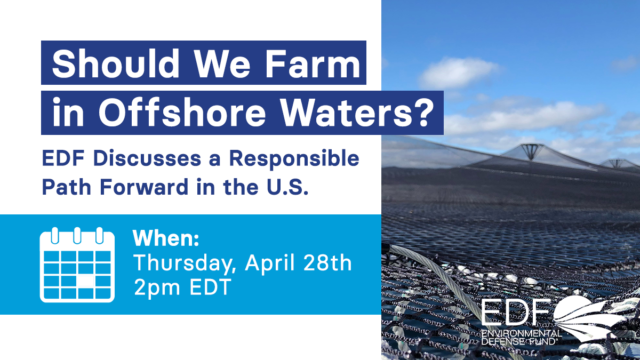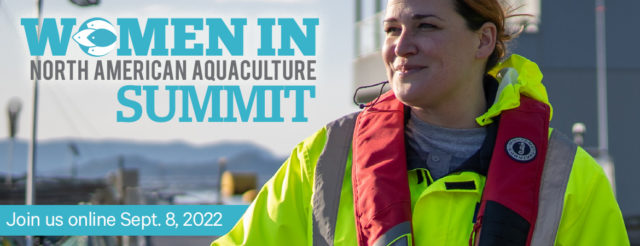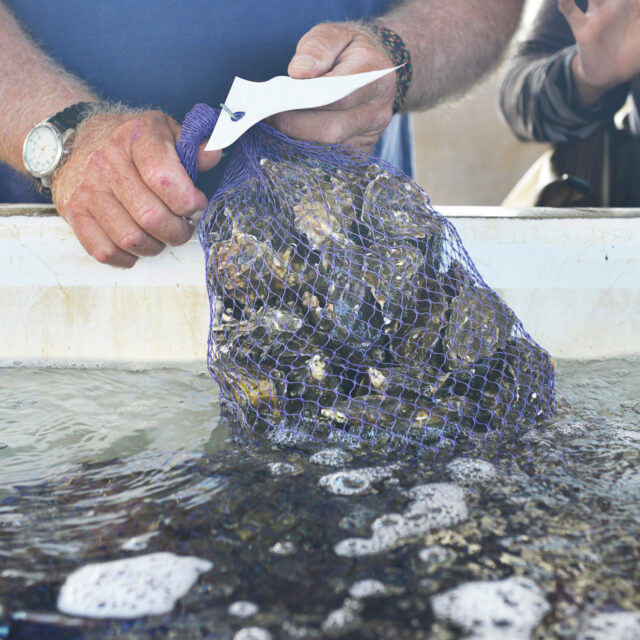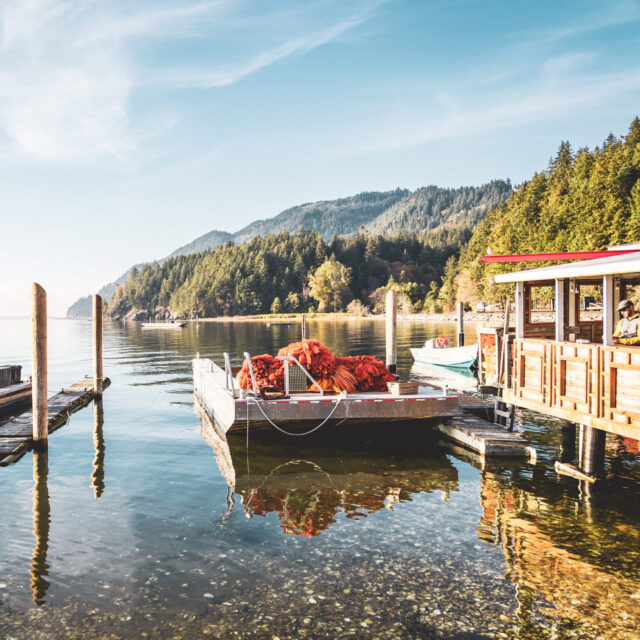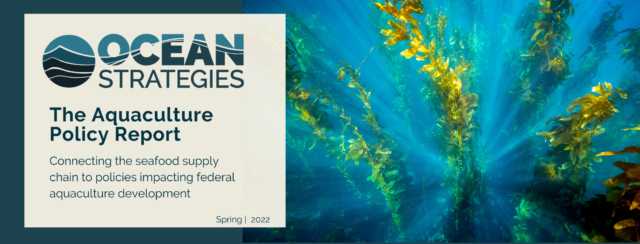
The Aquaculture Policy Report provides timely policy and industry updates connecting sectors across the seafood supply chain to aquaculture policy development.
Not already signed-up? Receive future updates by signing up.
WHAT WE’RE WATCHING IN FEDERAL AQUACULTURE POLICY
Update: Aquaculture Opportunity Areas
Opportunities for public comment critical to determining where and why of aquaculture sites
The next public comment period is on the horizon for NOAA’s Aquaculture Program as it ramps up to the Programmatic Environmental Impact Statement (PEIS) process for the first two Aquaculture Opportunity Areas (named in August 2020).
Stakeholder voices will be integral to the process of developing and expanding federal aquaculture opportunities, including representatives of America’s wild capture fisheries and seafood supply chain.
The AOA initiative began with a Trump-era executive order in May 2020 that laid out the process. Each of these steps incorporates a public comment period:
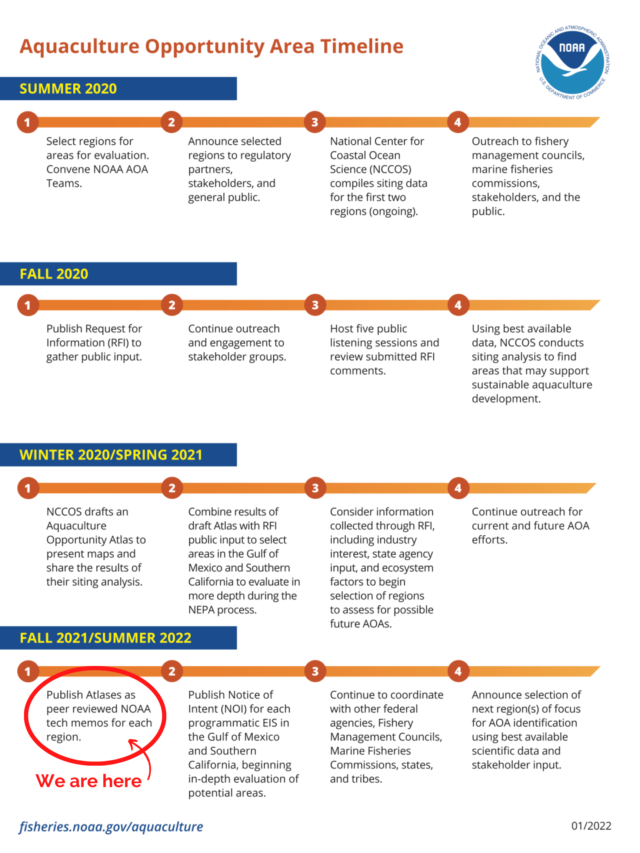
-
Within a year of the EO: Identify at least two geographic areas, in federal and/or state waters, suitable for commercial aquaculture.
-
In August 2020, the agency named the Gulf of Mexico and Southern California, and opened a 60-day public comment period in October 2020.
-
-
Within two years of IDing those areas: Complete a National Environmental Policy Act PEIS for each area.
-
As of April 2022, the agency has yet to begin a PEIS for either area. However, it laid out the AOA Atlases for both areas in November 2021, which is the last step before the PEIS process.
-
-
In the following four years: Identify two additional areas each year and complete a PEIS for each within two years, for a total of at least 10 areas identified over the course of five years.
So far, NOAA’s AOA initiative has received broad support as science-based and stakeholder driven. As the agency moves through the steps to expand aquaculture projects in domestic waters, stakeholder input throughout the supply chain will be critical to developing aquaculture investment that complements and expands our existing sustainable seafood chain.
U.S. agencies work toward first federal aqua plan update in 40 years
Comments closed on federal Aquaculture Economic Development Plan
Recent agency cooperation and public input into the Aquaculture Economic Development Plan is informing updates and priorities for federal research, regulation, technology transfer, and assistance programs. The federal plan, a process housed in a federal interagency group called the Subcommittee on Aquaculture (SCA), hasn’t been updated in nearly 40 years.
In May 2020, the SCA developed a Task Force to tackle a Strategic Plan supporting a “robust, resilient, and environmentally sustainable domestic aquaculture sector.” The SCA closed public comments on April 15 for its draft outline of that plan. This process is happening in parallel to the new policies and protocols being tackled within NOAA and Congressional legislation, as multiple agencies and industry sectors try to tackle what aquaculture development means for America.
The SCA mission includes changes to the National Strategic Plan for Aquaculture Research, and the Strategic Plan to Enhance Regulatory Efficiency in Aquaculture. The National Aquaculture Act of 1980 requires select federal agencies to update development plans as necessary, and momentum in aquaculture development is triggering review. The changes will serve as vital components in the interagency update to the National Aquaculture Development Plan, last completed in 1983.
Ocean Strategies will report back when agencies release summaries of public input and related plan changes.
The SCA is co-chaired by the Department of Agriculture, Department of Commerce, and the White House Office of Science and Technology Policy. The National Aquaculture Act requires the Secretary of Agriculture to confer with the heads of the other cooperating agencies, as well as members of the aquaculture industry and the regional fishery management councils when updating the NADP.
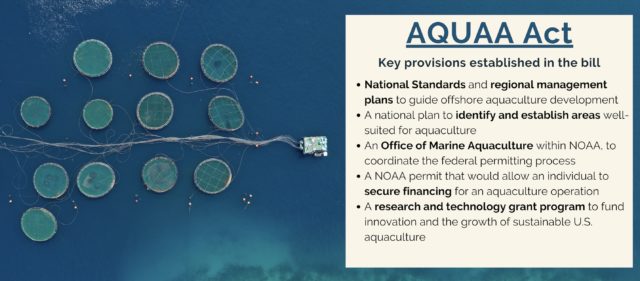
AQUAA Act reintroduction
Update: After the AQUAA Act’s reintroduction last year, little progress has been made in its advancement through the Senate. As we continue to track federal aquaculture policy development, stay tuned for updates on the AQUAA Act and any opportunities that arise to provide stakeholder input.
Situational Summary: Congressional members took a third swipe toward comprehensive aquaculture policy last year. The Advancing the Quality and Understanding of American Aquaculture Act (AQUAA Act) was reintroduced in the Senate on October 28, 2021 by Senators Roger Wicker (R-MS), Brian Schatz (D-HI), and Marco Rubio (R-FL). This bipartisan bill would establish regulations to advance aquaculture development in U.S. federal waters. The main provisions of the bill include aquaculture siting, permitting, monitoring and enforcement. This is the third time the bill has been introduced in Congress, and this iteration is identical to its previous version, causing pause for opponents that express concern over offshore aquaculture’s impact on the marine environment and the health and sustainability of wild-capture fisheries. Commercial fishermen want more information to understand what happens to seafood markets when flooded with new product, reminiscent of farmed salmon’s introduction in the 80’s and 90’s. Alaskans, who are a seafood political juggernaut, are adamant about a state’s right to opt-out of federal aquaculture, which was not included in this recent bill.
Proponents of the bill applaud the regulations it has laid out, as they state a major hindrance for the aquaculture industry’s responsible expansion has been the lack of a comprehensive regulatory framework and the many uncertainties within the permitting process. Supporters of increased domestic aquaculture production claim it will lead to less reliance on foreign seafood imports and therefore more food security for Americans. They also state the economic opportunity associated with aquaculture expansion, and how it will allow for the growth of other industries such as agriculture (feed production), manufacturing, and food processing and service. Working waterfronts also stand to benefit from increased activity and industry.
Aquaculture research amendment included in America COMPETES Act
The House of Representatives passed a $350 billion spending bill in February of this year, aimed at upping America’s ability to compete in global trade. The America Creating Opportunities for Manufacturing, Pre-Eminence in Technology, and Economic Strength Act of 2022 addresses national and economic security issues. It authorizes billions of dollars to boost domestic technology research, critical supply chains, and science, technology, engineering, and mathematics (STEM) education and training.
The Act contains a variety of fisheries and seafood provisions, including an amendment put forth by Rep. Ed Case (D-HI) that would establish a comprehensive study into offshore aquaculture including the environmental impact, identification of control technologies and practices to minimize environmental impacts, and assessment on the impact of international offshore aquaculture industries on the domestic seafood market.
What’s next: On March 28, the Senate overwhelmingly passed the U.S. Innovation and Competition Act (USICA), its version of the House’s America COMPETES Act. The Senate’s 68-28 vote will send the bill back to the House, where it is expected to be rejected. That should trigger a House and Senate conference to reconcile the differences between the bills.
AQUACULTURE BY REGION
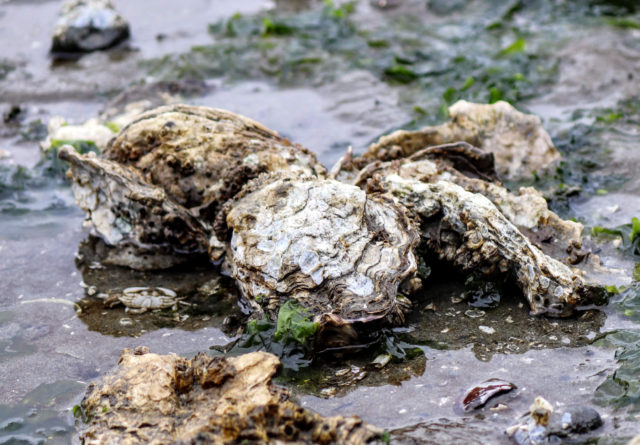
Aqua Spotlights Coast-to-Coast: Mariculture, Markets, Permits & More
North Pacific
Alaska mariculture industry momentum surges
Supporters of mariculture in Alaska are working to build a $100 million industry out of shellfish and seaweed over the next two decades.
The Alaska Mariculture Alliance, a successor group to former Alaska Governor Bill Walker’s Alaska Mariculture Task Force (reauthorized in 2018 by Governor Mike Dunleavy), is a newly established entity, administered by the Alaska Fisheries Development Foundation. Its mission is to “develop and support a robust and sustainable mariculture industry, producing shellfish and aquatic plants for the long-term benefit of Alaska’s economy, environment and communities.”
Earlier this year, the USDA awarded Juneau-based regional economic development organization, the Southeast Conference, $500,000 for a mariculture processing facility on Prince of Wales Island. Alaska’s seaweed industry faces infrastructure challenges, but investments like these will help save on costs and create new market opportunities.
Ocean Strategies is a proud associate member of the Alaska Mariculture Alliance.
West Coast
U.S. and European Union resume shellfish trade
In February 2022, the Biden administration announced the negotiation of a new trade agreement established between the U.S. and EU, allowing shellfish farmers to sell live, raw product to European customers for the first time since 2010.
Resuming trade will start in Massachusetts and Washington, opening the door to new markets for shellfish growers, as well as helping coastal communities and the seafood economy.
The Pacific Coast Shellfish Growers Association, applauded these efforts from Congress and the U.S. Trade Representative.
New England
Maine Aquaculture Roadmap released for 2022-32
The Maine Aquaculture Hub (a statewide public-private partnership) released a new 10-year roadmap for Maine’s aquaculture industry in January. The document incorporates feedback from upward of 150 stakeholders representing nearly 100 organizations and companies operating in Maine’s marine economy.
The full report notes that Maine’s Department of Marine Resources is now tracking the number of days from lease application to a hearing or decision. Anecdotally, this time line was improving pre-Covid, but any lease requiring a public hearing was put on indefinite hold as a result of pandemic-related shutdowns.
The report also praises Maine Rep. Chellie Pingree’s Keeping America’s Waterfronts Working Act, which has been incorporated into California Rep. Jared Huffman’s Magnuson Act reauthorization. Pingree’s proposal would allocate $4 million to recapitalize the Working Waterfront Preservation Program.
Gulf of Mexico
Texas oyster mariculture permits slow on the uptake
Texas launched its oyster mariculture industry in 2019, making it the last coastal state in the Gulf of Mexico to do so. The goals in establishing oyster farming in Texas were to contribute to economic growth, restore working waterfronts, offset the decline of wild fisheries, and rebuild habitat, which also benefits the sport fish industry.
Since the state opened its online portal for permitting, it has approved just three permits (one of which is conditional), and denied none. One permit holder says the process is laborious, given the requirement to work independently with state and federal agencies, tallying up to a roughly six-month process.
INDUSTRY LOGBOOK
Q & A with Diani Taylor
Brett: Diani, thanks so much for joining us today. We’re excited to tap into your expertise and insight into Washington’s shellfish industry. But first, we like to start with the hard questions: what is your favorite seafood and how do you prepare it?Diani: I’m going to break the rules and go with two answers because I have way too many favorites! First, I cook a lot of steamed clams at home – they’re simple and easy to change up. You just have to rinse the clams quickly, heat a pan, add butter, onions, and garlic, even some ginger and spicy sauce, and then white wine or chicken broth. Next, you let all of those ingredients boil, and add the clams and cover. Once they’re open all the way, they’re ready! You can eat it with some good bread or rice. It only takes about 3-4 minutes for the clams so it’s easy to overcook them.
Second, oysters on the half shell are impossible to beat. Folks can be hesitant because they don’t know how to shuck them, but there are some really great online tutorials. I love eating them because it’s a different experience every time and that makes it very special.
Brett: Moving into our policy discussion, the nation’s unfed aquaculture industry (or as some call, mariculture – seaweed and shellfish farming) continues to grow and expand, while also facing some uphill battles in terms of permitting and regulations. What are the policy issues that are most important to Taylor Shellfish and how do those relate to the WA aquaculture sector at large, and the national aquaculture landscape?
Diani: At Taylor Shellfish and throughout the aquaculture industry in general we track policy that relates to climate issues, such as ocean acidification and clean water. These issues are critical to farms and operations. Taylor Shellfish is also focused on some sector-specific work related to shellfish regulations and health and safety standards, as well as national shellfish regulations and making sure that process works for farmers. We’re also tracking the draft rules coming out of the Subcommittee on Aquaculture. These are forward looking rules that address regulatory challenges as well as economic and research needs for the industry.
One of the things we’re excited about is the work being done on shellfish genetics. Genetics are important to shellfish for a variety of reasons – we use it to make a more marketable product, but also address ocean acidification and make a more resilient oyster.
Brett: In February of this year, Washington’s shellfish industry received some fantastic news – a new trade agreement between the US and the European Union was established, which allows shellfish farmers to sell their product to European customers for the first time since 2010. What does this agreement mean for WA’s shellfish farmers and the country’s seafood sector in terms of new markets and the economy?
Diani: I am really excited about this! We’ve been trying to address this for over a decade. Before the ban we had a strong market in the EU and good connections with customers. The European market was for manila clams and that’s what we’re pursuing again. We’ve got incredible PNW clams and they’re in high demand in Europe. One important thing we’ve learned through Covid is that having diverse markets provides stability for your business.
Brett: Lastly, I want to bring attention to an important conversation that is happening in the seafood industry – that of establishing more female and diverse representation throughout the seafood supply chain, but most importantly ensuring there are more women in leadership positions. As a female leader in Washington’s seafood industry, what would your advice be to other women that want to get involved in the seafood policy discussion, and work toward establishing themselves in those leadership positions?
Diani: This is a really important topic. To have a robust industry, one that is healthy for the long term, it must be increasingly diverse and include more women. That needs to be a priority for the seafood industry as a whole.
My mom dug clams for over 10 years and was a huge inspiration to me as a female leader. Women are the future of farming. I am really lucky to have a lot of support and get to network with women, but not everyone has that. My advice for women that want to get into the seafood sector and those leadership positions is to build that network of women so you have others to support and guide you on your path in the industry.
I would be remiss to not give a shout-out to my sister and cousin that launched Girls That Shuck! This is an online group, mostly through Instagram, and they host space for women in the oyster industry to network, share their stories, and highlight each other’s work. They’re getting ready to launch their second Girls Who Shuck fundraiser. That’s a great way to give back to organizations working to support women in the seafood industry.
Brett: Well Diani, we really look up to you and are astonished by your expertise and the great work you’re doing. The seafood industry is lucky to have you as a part of it. Any final words of wisdom?
Diani: Thanks so much. One more thought on policy – there is a lot of opportunity for other industries and sectors to come together on some of the priorities for the seafood industry. I see this as a hugely untapped potential. From the Taylor Shellfish lens, we can work together with others on issues like ocean acidification. Some of the greatest work we’ve seen is when groups come together on their aligned priorities.
WOMEN IN AQUACULTURE
Establishing more female and diverse representation throughout the seafood industry is a vital component in ensuring an environmentally and economically sustainable supply chain.
Most importantly, incorporating the skill and expertise of women into seafood industry leadership and decision-making positions, especially as it relates to discussions around climate issues and seafood-related policies, helps us to achieve a viable and thriving food production system.
Here are a few resources highlighting female leadership and involvement within the U.S. aquaculture industry.
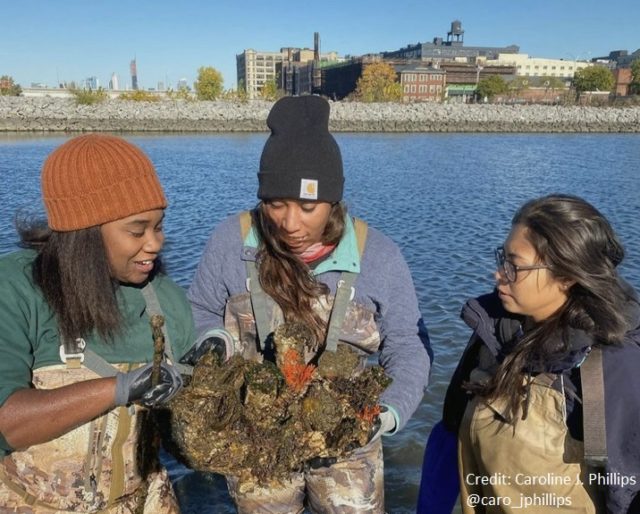
Inclusivity & Aquaculture: An interview with Imani Black
Last month, the Environmental Defense Fund (EDF) connected with Imani Black, founder of Minorities in Aquaculture to understand how to foster more diversity and inclusivity in the traditionally white, male aquaculture industry.
Read more from EDF’s blog here.
New podcast: Women in North American Aquaculture
Aquaculture North America, in partnership with Merck Animal Health, launched a new project in January 2022, celebrating women in the North American industry.
Women in North American Aquaculture, or WINAA, aims to understand the road to gender equality in the industry. Part of the new project includes a monthly podcast series, featuring influential women and how they’ve made an impact.
EVENTS & OPPORTUNITIES
Want to be more involved? Check out these opportunities to learn, lead and engage.
The Northeast Aquaculture Conference & Exposition (NACE) will be held in Portland, ME April 27-29. This event includes multiple workshops, field trips and a trade show featuring 40 vendors servicing the aquaculture industry.
Our team will be at NACE this year!
Feel free to reach out if you are attending: jes@oceanstrat.com
Join the Environmental Defense Fund for this virtual event on April 28, where their team will discuss what a responsible path forward for federal aquaculture development may look like, followed by a Q&A with the audience. Register here.
Women in North American Aquaculture Summit, or WINAAS, aims to understand the road to equal opportunity in the industry. This live virtual event welcomes men and women in North American aquaculture to tackle solutions for equal pay, entrepreneurship, innovation, training and mentorship. You can register here.
